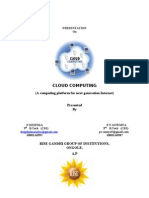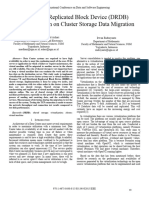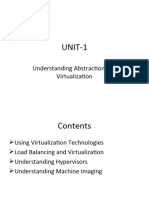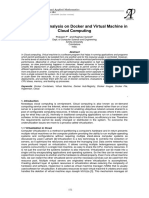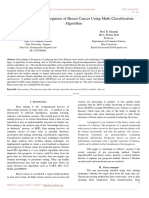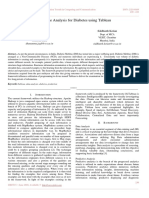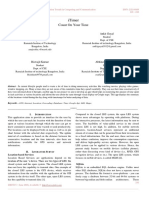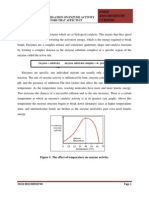IO Workload in Virtualized Data Center Using Hypervisor
Uploaded by
Editor IJRITCCIO Workload in Virtualized Data Center Using Hypervisor
Uploaded by
Editor IJRITCCInternational Journal on Recent and Innovation Trends in Computing and Communication
Volume: 2 Issue: 8
ISSN: 2321-8169
2256 2260
_______________________________________________________________________________________________
I/O Workload in Virtualized Data Center Using Hypervisor
Mr.M.Rajesh
Dr .G.Singaravel
Research Scholar, Bharath University,
Chennai.
goldmraja@gmail.com
Professor and Head of information technology
K.S.R college of Engineering (Autonomous),
Tiruchengode.
singaravelg@gmail.com
Abstract: Cloud computing [10] is gaining popularity as its the way to virtualize the datacenter and increase flexibility in the use of
computation resources. This virtual machine approach can dramatically improve the efficiency, power utilization and availability of costly
hardware resources, such as CPU and memory. Virtualization in datacenter had been done in the back end of Eucalyptus software and Front end
was installed on another CPU. The operation of performance measurement had been done in network I/O applications environment of virtualized
cloud. Then measurement was analyzed based on performance impact of co-locating applications in a virtualized cloud in terms of throughput
and resource sharing effectiveness, including the impact of idle instances on applications that are running concurrently on the same physical
host. This project proposes the virtualization technology which uses the hypervisor to install the Eucalyptus software in single physical machine
for setting up a cloud computing environment. By using the hypervisor, the front end and back end of eucalyptus software will be installed in the
same machine. The performance will be measured based on the interference in parallel processing of CPU and network intensive workloads by
using the Xen Virtual Machine Monitors. The main motivation of this project is to provide the scalable virtualized datacenter.
Keywords: Cloud computing, virtualization, Hypervisor, Eucalyptus.
__________________________________________________*****_________________________________________________
INTRODUCTION
Cloud Computing [1] is more than a collection
of computer resources as it provides a mechanism to manage
those resources. It is the delivery of computing as a service
rather than a product, whereby shared resources, software, and
information are provided to computers and other devices as a
utility over a network. A Cloud Computing platform supports
redundant, self-recovering, highly scalable programming
models that allow workloads to recover from many inevitable
hardware/software failures. The concept of cloud computing
and virtualization offers so many innovative opportunities that
it is not surprising that there are new announcements every
day.
Fig no. 1 Cloud Computing Architecture
It is defined as a pool of virtualized computer
resources. Based on this virtualization the Cloud Computing
paradigm allows workloads to be deployed and scaled-out
quickly through the rapid provisioning of virtual machines or
physical machines. In a Cloud Computing platform software is
migrating from the desktop into the "clouds" of the Internet,
promising users anytime, anywhere access to their programs
and data. The innovation will continue and there will be
massive value created for customers over the coming years.
Most technologists are sold on the fundamentals of cloud
computing and it's a realization of the last 20 years of
architecture development.
It describes a new supplement, consumption, and
delivery model for IT services based on Internet protocols, and
it typically involves provisioning of dynamically scalable and
often virtualized resources. It provides computation, software,
data access, and storage services that do not require end-user
knowledge of the physical location and configuration of the
system that delivers the services.
Cloud computing providers deliver applications
via the internet, which are accessed from a web browser, while
the business software and data are stored on servers at a
remote location. In some cases, legacy applications (line of
business applications that until now have been prevalent in
thin client Windows computing) are delivered via a screensharing technology, while the computing resources are
consolidated at a remote data center location; in other cases,
entire business applications have been coded using web-based
technologies such as AJAX.
In this paper, performance interference among
different VMs is running on the same hardware platform with
the focus on network I/O processing. The main motivation for
targeting our measurement study on performance interference
of processing concurrent network I/O workloads in virtualized
environment is simply because network I/O applications are
becoming dominating workloads in current cloud computing
systems. By carefully design of our measurement study and
the set of performance metrics we use to characterize the
network I/O workloads, we derive some important factors of
I/O performance conflicts based on application throughput
interference and net I/O interference. Our performance
2256
IJRITCC | August 2014, Available @ http://www.ijritcc.org
_______________________________________________________________________________________
International Journal on Recent and Innovation Trends in Computing and Communication
Volume: 2 Issue: 8
ISSN: 2321-8169
2256 2260
_______________________________________________________________________________________________
measurement and workload analysis also provide some
insights on performance optimizations for CPU scheduler and
I/O channel and efficiency management of workload and VM
configurations
VIRTUALIZATION
Virtualization [9],[6],[5] in computing is a process of
creating virtual (rather than actual) version of something, such
as a hardware platform, operating system, a storage device or
network resources. It is a software acts like hardware. The
software used for virtualization is known as hypervisors. There
are different types of hypervisors which are used for
virtualization like, XEN, VMware, and KVM.
XEN HYPERVISOR
Xen is a Virtual-Machine Monitor (VMM) providing
services that allow multiple computer operating systems to
execute on the same computer hardware concurrently. The
Xen community develops and maintains Xen as free software,
licensed under the GNU General Public License (GPLv2). It is
available for the IA-32, x86-64, Itanium and ARM computer
architectures.
VMWARE
VMware is proprietary software developed in 1998
and based in Palo Alto, California, USA. It is majorly owned
by Corporation. VMwares desktop software runs on
Microsoft Windows, Linux, and Mac OS X, while VMware's
enterprise software hypervisors runs for servers, VMware ESX
and VMware ESXi, are bare-metal embedded hypervisors that
run directly on server hardware without requiring an additional
underlying operating system.
Kernel-based Virtual Machine (KVM)
KVM provides infrastructure virtualization for the
Linux kernel. KVM supports native virtualization on
processors with hardware virtualization extensions. This
supports a paravirtual Ethernet card, a paravirtual disk I/O
controller, a balloon device for adjusting guest memory-usage,
and VGA graphics interface using SPICE or VMware drivers.
PARAVIRTUALIZATION
Paravirtualization is a virtualization technique that
provides a software interface to virtual machines that is similar
but not identical to that of the underlying hardware. The intent
of the modified interface is to reduce the portion of the guest's
execution time spent for performing operations which are
substantially more difficult to run in a virtual environment
compared to a non-virtualized environment.
The paravirtualization provides specially defined
'hooks' to allow the guest(s) and host to request and
acknowledge these tasks, which would otherwise be executed
in the virtual domain. A successful paravirtualized platform
may allow the Virtual Machine Manager (VMM) to be simpler
and reduce the overall performance degradation of machineexecution inside the virtual-guest.
Credit-Based CPU Scheduler
Introduction
The credit scheduler[4] is a proportional fair share
CPU scheduler built from the ground up to be work
conserving on SMP hosts. It is now the default scheduler in
the Xen-unstable trunk. The SEDF and BVT schedulers are
still optionally available but the plan of record is for them to
be phased out and eventually removed.
Description
Each domain (including Host OS) is assigned
a weight and a cap.
Weight: A domain with a weight of 512 will get twice as
much CPU as a domain with a weight of 256 on a contended
host. Legal weights range from 1 to 65535 and the default is
256.
Cap: The cap optionally fixes the maximum amount of CPU a
domain will be able to consume, even if the host system has
idle CPU cycles. The cap is expressed in percentage of one
physical CPU: 100 is 1 physical CPU, 50 is half a CPU, 400 is
4 CPUs, etc... The default, 0, means there is no upper cap.
Smp Load Balancing
The credit scheduler performs automatic load
balances among guest VCPUs across all available physical
CPUs on an SMP host. The administrator does not need to
manually pin VCPUs to load balance the system.
Algorithms
Each CPU manages a local run queue of runnable
VCPUs. This queue is sorted by VCPU priority. A VCPU's
priority can be one of the two value, they are
over or under representing whether this VCPU has or hasn't
yet exceeded its fair share of CPU resource in the ongoing
accounting period. When inserting a VCPU onto a run queue,
it is put after all other VCPUs of equal priority to it.
As a VCPU runs, it consumes credits. Every so
often, a system-wide accounting thread recomputes how many
credits each active VM has earned and bumps the credits.
Negative credits imply a priority of over. Until a VCPU
consumes its allotted credits, it priority is under.
On each CPU, at every scheduling decision, the
next VCPU to run is picked off the head from the run queue.
The scheduling decision is the common path of the scheduler
and is therefore designed to be light weight and efficient. No
accounting takes place in this code path.
When a CPU doesn't find a VCPU of
priority under on its local run queue, it will look on other
CPUs for one. This load balancing guarantees that each VM
receives its fair share of CPU resources system-wide. Before a
2257
IJRITCC | August 2014, Available @ http://www.ijritcc.org
_______________________________________________________________________________________
International Journal on Recent and Innovation Trends in Computing and Communication
Volume: 2 Issue: 8
ISSN: 2321-8169
2256 2260
_______________________________________________________________________________________________
CPU goes idle, it will look on other CPUs to find any runnable
VCPU. This guarantees that no CPU remains idles when there
is runnable work in the system.
Related work
Most of the efforts to date can be classified into three
main categories: (1) performance monitoring and enhancement
of VMs hosted on a single physical machine (2) performance
evaluation, enhancement, and migration of VMs running on
multiple physical hosts(3) performance comparison conducted
with different platforms or different implementations of
VMMs, such as Xen and KVM , as well as the efforts on
developing benchmarks Given that the focus of this paper is
on performance measurement and analysis of network I/O
applications in a virtualized single host, in this section we
provide a brief discussion on the state of art in literature to
date on this topic. Most of the research on virtualization in a
single host has been focused on either developing the
performance monitoring or profiling tools for VMM and VMs,
represented by or conducting performance evaluation work by
varying VM configurations on host capacity utilization or by
varying CPU scheduler configurations, especially for I/O
related performance measurements. For example, some work
has focused on I/O performance improvement by tuning I/O
related parameter such as TCP Segmentation Offload, network
bridging.
PROPOSED SYSTEM ARCHITECTURE
Proposed Architecture
Here the virtualization technology which uses the hypervisor
to install the Eucalyptus software in single physical machine
for setting up a cloud computing environment. By using the
hypervisor, the front end and back end of eucalyptus software
will be installed in the same machine. The performance will be
measured based on the interference in parallel processing of
CPU and network intensive workloads by using the Xen
Virtual Machine Monitors.
EXPERIMENTAL SETUP
A new open-source framework called Eucalyptus
has been released that allows users to create private cloud
computing grids that are API-compatible with the existing
Amazon
standards.
Eucalyptus
leverages
existing
virtualization technology (the KVM or Xen hypervisors) and
popular Linux distributions.
To test Eucalyptus, a simplified two-node cluster
was used. A front-end node with two network interfaces was
connected to both the campus network and a private test
network, and a back-end node was connected only to the
private network. Both networks ran at gigabit speeds. The
private network was configured to support jumbo frames with
a 9000 byte MTU to accelerate EBS performance.
The ATA over Ethernet protocol used as the transport
mechanism behind EBS limits the disk request size to a single
Ethernet frame for simplicity, and fragments larger client
requests. Thus, using the largest Ethernet frame size possible
for both uses the disk more efficiently and reduces the
protocol overhead in relation to the payload. The front-end
node was equipped with two AMD Opteron processors
running at 2.4GHz with 4GB of RAM and a 500GB hard
drive.
It was configured to run the CLC, CC, EBS, and
WS3 services. The back-end node was equipped with two
Quad-Core AMD Opteron processors running at 3.1GHz with
16GB of RAM and a 500GB hard drive. These processors
support the AMD-V virtualization extensions as required for
KVM support in Linux. The back-end node was configured to
run the NC service and all virtual machine images.
To provide a performance baseline, the storage and
network components were profiled outside of the virtual
machine. For storage, the Seagate Barracuda 7200.11 500GB
hard drive has a peak read and write bandwidth of
approximately 110MB/s, assuming large block sizes (64kB+)
and streaming sequential access patterns. For networking the
virtual switch was provided for bridging. In an ideal cloud
computing system, this performance would be available to
applications running inside the virtual environment.
Eucalyptus with KVM
In the first configuration, Eucalyptus with the KVM
hypervisor was used. This is a default installation of Ubuntu
Enterprise Cloud (UEC), which couples Eucalyptus 1.60 with
the latest release of Ubuntu 9.10. The key benefit of UEC is
ease-of-installation as it took less than 30 minutes to install
and configure the simple two-node system.
Eucalyptus with Xen
Eucalyptus was used with the Xen hypervisor. Unfortunately,
Ubuntu 9.10 is not compatible with Xen when used as the host
domain (only as a guest domain). Thus, the Centos 5.4
distribution was used instead because of its native
compatibility with Xen
2258
IJRITCC | August 2014, Available @ http://www.ijritcc.org
_______________________________________________________________________________________
International Journal on Recent and Innovation Trends in Computing and Communication
Volume: 2 Issue: 8
ISSN: 2321-8169
2256 2260
_______________________________________________________________________________________________
PERFORMANCE METRICS
The following metrics are used in our measurement
study. They are collected using Xenmon [8] and Xentop [15].
Server throughput (#req/sec). It quantitatively measures
the maximum number of successful requests served per second
when retrieving web documents.
Normalized throughput. We typically choose one measured
throughput as our baseline reference throughput and normalize
the throughputs of different configuration settings in order to
make adequate comparison.
Aggregated throughput (#req/sec). We use aggregated
throughput as a metric to measure the impact of using varying
number of VMs on the aggregated throughput performance of
a physical host.
CPU utilization (%). To understand the CPU resource
sharing across VMs running on a single physical machine, we
measure the average CPU utilization of each VM, including
Domain0 CPU usage and guest domain CPU usage
respectively.
Network I/O per second (Kbytes/sec). We measure the
amount of network I/O traffic in KB per second, transferred
from a remote web server for the corresponding workload.
IMPACT ANALYSIS
In this section we provide a detailed performance
analysis of maintaining idle VM instances, focusing on the
cost and benefit of maintaining idle guest domains in the
presence of network I/O workloads on a separate VM sharing
the same physical host. Concretely, we focus our measurement
study on addressing the following two questions: First, we
want to understand the advantages and drawbacks of keeping
idle instances from the perspectives of both cloud providers
and cloud consumers. Second, we want to measure and
understand the start-up time of creating one or more new guest
domains on a physical host, and its impact on existing
applications. Consider a set of n (n>0) VMs hosted on a
physical machine, at any given point of time, a guest domain
(VM) can be in one of the following three states: (1) execution
state, namely the guest domain is currently using CPU; (2)
runnable state, namely the guest domain is on the run queue,
waiting to be scheduled for execution on the CPU; and (3)
blocked state, namely the guest domain is blocked and is not
on the run queue. A guest domain is called idle when the guest
OS is executing idle-loop.
MEASUREMENT
we set up our environment with one VM (VM1) running one
of the six selected network I/O workloads of 1 KB, 4 KB, 30
KB, 50 KB, 70 KB and 100 KB. The value of each I/O
workload characteristics is measured at 100% workload rate
for the given workload type. Comparing with networkintensive workloads of 30 KB, 50 KB, 70 KB, and 100 KB
files, the CPU-intensive workloads of 1 KB and 4 KB files
have at least 30% and 60% lower event and switch costs
respectively because the network I/O processing is more
efficient in these cases. Then normalized throughput, CPU
utilization and Network I/O between Domain1 and Domain2,
both with identical 1kB application at 50% workload rate.
Concretely, for 1 KB and 4 KB workloads, driver domain has
to wait about 2.5 times longer on the CPU run queue for being
scheduled into the execution state and the guest domain
(VM1) has 30 times longer waiting time. However, they are
infrequently blocked for acquiring more CPU resource,
especially in the guest domain the block time is less than 6%.
We notice that the borderline network-intensive 10 KB
workload has the most efficient I/O processing ability with
7.28 pages per execution while the event and switch numbers
are 15% larger than CPU-intensive workloads. Interesting to
note is that initially, the I/O execution is getting more and
more efficient as file size increases. However, with file size of
workload grows larger and larger, more and more packets
need to be delivered for each request. The event and switch
number are increasing gradually as observed. Note that the
VMM events per second are also related to request rate of the
workload. Though it drops slightly for the workload of file
size 30-100 KB, the overall event number of networkintensive workloads is still higher than CPU-intensive ones.
With increasing file size of shorter workloads (1 KB, 4 KB
and 10 KB), VMs are blocked more and more frequently.
Finally, I/O execution starts to decline when the file size is
greater than 10 KB. The network I/O workloads that exhibit
CPU bound are now transformed to network bounded as the
file size of the workloads exceeding 10 KB and the contention
for network resource is growing higher as the file size of the
workload increases. In our experiments, the 100 KB workload
shows the highest demand for the network resource. These
basic system level characteristics in our basecase scenario can
help us to compare and understand better the combination of
different workloads and the multiple factors that may cause
different levels of performance interferences with respect to
both throughput and net I/O.
CONCLUSION
2259
IJRITCC | August 2014, Available @ http://www.ijritcc.org
_______________________________________________________________________________________
International Journal on Recent and Innovation Trends in Computing and Communication
Volume: 2 Issue: 8
ISSN: 2321-8169
2256 2260
_______________________________________________________________________________________________
Cloud computing offers scalable infrastructure and
software off site, saving labor, hardware, and power costs.
Financially, the clouds virtual resources are typically cheaper
than dedicated physical resources connected to a personal
computer or network. This project proposes the virtualization
technology of using the hypervisor to install the Eucalyptus
software in single physical machine. By using the hypervisor,
the front end and back end will be installed in the same
machine. Then performance will be measured based on the
interference in parallel processing of CPU and network
intensive workloads by using the Xen Virtual Machine
Monitors. The main motivation of this project is to provide
the scalable virtualized data center.
[13]
[14]
[15]
Virtualized Data Centers IEEE transactions on
service computing,2010.
Single Root I/O Virtualization and Sharing
Specification revision 1.0, specification by Peripheral
Component Interconnect Special Interest Group,
Sept. 2007.
D. Gupta, R. Gardner, L. Cherkasova, XenMon: QoS
Monitoring and Performance Profiling Tool,
http://www.hpl.hp.com/techreports/2005/HPL-2005187.html
REFERENCES:
[1]
[2]
[3]
[4]
[5]
[6]
[7]
Chen.V,Kaeli.D, and Murphy.D, Performance
Evaluation of Virtual Appliances, Proc. First
International
Workshop
on
Virtualization
Performance: Analysis, Characterization, and Tools
(VPACT 08), April, 2008.
Chinni.s and Hiremane .R, Virtual Machine Device
Queues: An Integral Part of Intel Virtualization
Technology for Connectivity that Delivers Enhanced
Network Performance, white paper, Intel, 2007.
Gupta, R. Gardner, L. Cherkasova, XenMon: QoS
Monitoring and Performance Profiling Tool,
http://www.hpl.hp.com/techreports/2005/HPL-2005187.html
www.xen.org/files/summit_3/sched.pdf
P. Padala, X. Zhu, Z. Wang, S. Singhal and K. Shin,
Performance
evaluation
of
virtualization
technologies for server consolidation, HP
Laboratories
Report,
NO.
HPL-2007-59R1,
September 2008..
R. Rose, Survey of system virtualization
techniques, Technical report, March 2004
S. Wardley, E. Goyer, and N. Barcet. Ubuntu
enterprise cloud architecture. Technical report,
Canonical, August 2009.
[8]
http://linux.die.net/man/1/xentop
[9]
P. Padala, X. Zhu, Z. Wang, S. Singhal and K. Shin,
Performance
evaluation
of
virtualization
technologies for server consolidation, HP
Laboratories
Report,
NO.
HPL-2007-59R1,
September 2008.
http://en.wikipedia.org/wiki/Cloud_computing
KVM http://www.linux-kvm.org/page/Main_PageP.
Yiduo Mei, Ling Liu, Senior Member, IEEE,Xing Pu,
Sankaran Sivathanu, and Xiaoshe Dong ,
Performance Analysis of Network I/O Workloads in
[10]
[11]
[12]
2260
IJRITCC | August 2014, Available @ http://www.ijritcc.org
_______________________________________________________________________________________
You might also like
- Cloud Computing: (A Computing Platform For Next-Generation Internet)No ratings yetCloud Computing: (A Computing Platform For Next-Generation Internet)7 pages
- A Comparative Survey On Function of Virtualization in Cloud EnvironmentNo ratings yetA Comparative Survey On Function of Virtualization in Cloud Environment4 pages
- Cloud Infrastructure and Security NotesNo ratings yetCloud Infrastructure and Security Notes13 pages
- An Updated Performance Comparison of Virtual Machines and Linux ContainersNo ratings yetAn Updated Performance Comparison of Virtual Machines and Linux Containers15 pages
- Chapter-1: Cloud Computing FundamentalsNo ratings yetChapter-1: Cloud Computing Fundamentals42 pages
- Virtualization Technique in Business Information TechnologyNo ratings yetVirtualization Technique in Business Information Technology6 pages
- Cloud Computing 18CS72: Microsoft Windows AzureNo ratings yetCloud Computing 18CS72: Microsoft Windows Azure10 pages
- Ijcet: International Journal of Computer Engineering & Technology (Ijcet)No ratings yetIjcet: International Journal of Computer Engineering & Technology (Ijcet)5 pages
- A Survey of Present Research On Virtual ClusterNo ratings yetA Survey of Present Research On Virtual Cluster10 pages
- Comp Sci - IJCSEITR - POLVMParallel Optimized Live VM Migration - Jayasree PNo ratings yetComp Sci - IJCSEITR - POLVMParallel Optimized Live VM Migration - Jayasree P16 pages
- Virtualization in Distributed System: A Brief Overview100% (1)Virtualization in Distributed System: A Brief Overview5 pages
- Welcome To International Journal of Engineering Research and Development (IJERD)No ratings yetWelcome To International Journal of Engineering Research and Development (IJERD)5 pages
- Cloud Computing: Hottest Buzzword in Information TechnologyNo ratings yetCloud Computing: Hottest Buzzword in Information Technology19 pages
- Ijesrt: Improve Virtualization Technique Using Packet Aggregation MechanismNo ratings yetIjesrt: Improve Virtualization Technique Using Packet Aggregation Mechanism4 pages
- Data Center Evolu - On and The "Cloud": Paul A. Strassmann George Mason University November 5, 2008, 7:20 To 10:00 PMNo ratings yetData Center Evolu - On and The "Cloud": Paul A. Strassmann George Mason University November 5, 2008, 7:20 To 10:00 PM38 pages
- Comparative Analysis On Docker and Virtual Machine in Cloud ComputingNo ratings yetComparative Analysis On Docker and Virtual Machine in Cloud Computing10 pages
- Term Paper - Virtualization in Cloud ComputingNo ratings yetTerm Paper - Virtualization in Cloud Computing10 pages
- Understanding Performance Interference of IO WorkloadNo ratings yetUnderstanding Performance Interference of IO Workload8 pages
- Proxy Re Encryptions (Pre) Based Deduplication Scheme On Encrypted Big Data For Cloud AbstractNo ratings yetProxy Re Encryptions (Pre) Based Deduplication Scheme On Encrypted Big Data For Cloud Abstract31 pages
- Dr. M. Sri Devi Sameera Associate Professor Dept of CSE Dhanekula Inst of Eng & TechNo ratings yetDr. M. Sri Devi Sameera Associate Professor Dept of CSE Dhanekula Inst of Eng & Tech100 pages
- Virtualization: Transforming The IT LandscapeByNo ratings yetVirtualization: Transforming The IT LandscapeBy22 pages
- Title: Virtualization in Cloud ComputingNo ratings yetTitle: Virtualization in Cloud Computing3 pages
- Cloud Computing Made Simple: Navigating the Cloud: A Practical Guide to Cloud ComputingFrom EverandCloud Computing Made Simple: Navigating the Cloud: A Practical Guide to Cloud ComputingNo ratings yet
- Channel Estimation Techniques Over MIMO-OFDM SystemNo ratings yetChannel Estimation Techniques Over MIMO-OFDM System4 pages
- A Review of 2D &3D Image Steganography TechniquesNo ratings yetA Review of 2D &3D Image Steganography Techniques5 pages
- A Review of Wearable Antenna For Body Area Network ApplicationNo ratings yetA Review of Wearable Antenna For Body Area Network Application4 pages
- A Review of 2D &3D Image Steganography TechniquesNo ratings yetA Review of 2D &3D Image Steganography Techniques5 pages
- A Study of Focused Web Crawling TechniquesNo ratings yetA Study of Focused Web Crawling Techniques4 pages
- IJRITCC Call For Papers (October 2016 Issue) Citation in Google Scholar Impact Factor 5.837 DOI (CrossRef USA) For Each Paper, IC Value 5.075No ratings yetIJRITCC Call For Papers (October 2016 Issue) Citation in Google Scholar Impact Factor 5.837 DOI (CrossRef USA) For Each Paper, IC Value 5.0753 pages
- Importance of Similarity Measures in Effective Web Information RetrievalNo ratings yetImportance of Similarity Measures in Effective Web Information Retrieval5 pages
- Channel Estimation Techniques Over MIMO-OFDM SystemNo ratings yetChannel Estimation Techniques Over MIMO-OFDM System4 pages
- A Review of Wearable Antenna For Body Area Network ApplicationNo ratings yetA Review of Wearable Antenna For Body Area Network Application4 pages
- Diagnosis and Prognosis of Breast Cancer Using Multi Classification AlgorithmNo ratings yetDiagnosis and Prognosis of Breast Cancer Using Multi Classification Algorithm5 pages
- Predictive Analysis For Diabetes Using Tableau: Dhanamma Jagli Siddhanth KotianNo ratings yetPredictive Analysis For Diabetes Using Tableau: Dhanamma Jagli Siddhanth Kotian3 pages
- Hybrid Algorithm For Enhanced Watermark Security With Robust DetectionNo ratings yetHybrid Algorithm For Enhanced Watermark Security With Robust Detection5 pages
- BUSINESS DIARY - An Interactive and Intelligent Platform For SME'sNo ratings yetBUSINESS DIARY - An Interactive and Intelligent Platform For SME's3 pages
- Safeguarding Data Privacy by Placing Multi-Level Access RestrictionsNo ratings yetSafeguarding Data Privacy by Placing Multi-Level Access Restrictions3 pages
- An Approach For Power Control in Vehicular Adhoc Network For Catastrophe MessageNo ratings yetAn Approach For Power Control in Vehicular Adhoc Network For Catastrophe Message7 pages
- Image Restoration Techniques Using Fusion To Remove Motion BlurNo ratings yetImage Restoration Techniques Using Fusion To Remove Motion Blur5 pages
- Paper On Design and Analysis of Wheel Set Assembly & Disassembly Hydraulic Press MachineNo ratings yetPaper On Design and Analysis of Wheel Set Assembly & Disassembly Hydraulic Press Machine4 pages
- 1.0 Abstract: in Today's Information Technology World, Security For Systems Is BecomingNo ratings yet1.0 Abstract: in Today's Information Technology World, Security For Systems Is Becoming27 pages
- Dupont Personal Protection Instruction Manual For Universal Pressure Test Kit No. 990810No ratings yetDupont Personal Protection Instruction Manual For Universal Pressure Test Kit No. 99081012 pages
- PALO ALTO - Getting Started: Quality of ServiceNo ratings yetPALO ALTO - Getting Started: Quality of Service12 pages
- Section 14 - Roofing Part 2 - Membrane Roofing 2.5 Modified Bitumen Membrane RoofingNo ratings yetSection 14 - Roofing Part 2 - Membrane Roofing 2.5 Modified Bitumen Membrane Roofing9 pages
- Helicopter Decks: Offshore Standard DNV-OS-E401No ratings yetHelicopter Decks: Offshore Standard DNV-OS-E40125 pages
- Introduction To SDRAM and Memory ControllersNo ratings yetIntroduction To SDRAM and Memory Controllers31 pages
- Gear Manufacturing Methods: Prepared by Kaushal PatelNo ratings yetGear Manufacturing Methods: Prepared by Kaushal Patel42 pages
- Chevrolet 1980 LT Services - 6 E-F - Control Emisiones y EscapeNo ratings yetChevrolet 1980 LT Services - 6 E-F - Control Emisiones y Escape48 pages
- ENG - Olympian - 404 Series - Recommended Spares - LEXF3222No ratings yetENG - Olympian - 404 Series - Recommended Spares - LEXF32221 page
- PD2083-EL-HAZ-A1-004.pdf HAZARDOUS AREA CLASSIFICATION SV STATION-3100% (1)PD2083-EL-HAZ-A1-004.pdf HAZARDOUS AREA CLASSIFICATION SV STATION-31 page
- Cloud Computing: (A Computing Platform For Next-Generation Internet)Cloud Computing: (A Computing Platform For Next-Generation Internet)
- A Comparative Survey On Function of Virtualization in Cloud EnvironmentA Comparative Survey On Function of Virtualization in Cloud Environment
- An Updated Performance Comparison of Virtual Machines and Linux ContainersAn Updated Performance Comparison of Virtual Machines and Linux Containers
- Virtualization Technique in Business Information TechnologyVirtualization Technique in Business Information Technology
- Ijcet: International Journal of Computer Engineering & Technology (Ijcet)Ijcet: International Journal of Computer Engineering & Technology (Ijcet)
- Comp Sci - IJCSEITR - POLVMParallel Optimized Live VM Migration - Jayasree PComp Sci - IJCSEITR - POLVMParallel Optimized Live VM Migration - Jayasree P
- Virtualization in Distributed System: A Brief OverviewVirtualization in Distributed System: A Brief Overview
- Welcome To International Journal of Engineering Research and Development (IJERD)Welcome To International Journal of Engineering Research and Development (IJERD)
- Cloud Computing: Hottest Buzzword in Information TechnologyCloud Computing: Hottest Buzzword in Information Technology
- Ijesrt: Improve Virtualization Technique Using Packet Aggregation MechanismIjesrt: Improve Virtualization Technique Using Packet Aggregation Mechanism
- Data Center Evolu - On and The "Cloud": Paul A. Strassmann George Mason University November 5, 2008, 7:20 To 10:00 PMData Center Evolu - On and The "Cloud": Paul A. Strassmann George Mason University November 5, 2008, 7:20 To 10:00 PM
- Comparative Analysis On Docker and Virtual Machine in Cloud ComputingComparative Analysis On Docker and Virtual Machine in Cloud Computing
- Understanding Performance Interference of IO WorkloadUnderstanding Performance Interference of IO Workload
- Proxy Re Encryptions (Pre) Based Deduplication Scheme On Encrypted Big Data For Cloud AbstractProxy Re Encryptions (Pre) Based Deduplication Scheme On Encrypted Big Data For Cloud Abstract
- Dr. M. Sri Devi Sameera Associate Professor Dept of CSE Dhanekula Inst of Eng & TechDr. M. Sri Devi Sameera Associate Professor Dept of CSE Dhanekula Inst of Eng & Tech
- Cloud Computing Made Simple: Navigating the Cloud: A Practical Guide to Cloud ComputingFrom EverandCloud Computing Made Simple: Navigating the Cloud: A Practical Guide to Cloud Computing
- Channel Estimation Techniques Over MIMO-OFDM SystemChannel Estimation Techniques Over MIMO-OFDM System
- A Review of Wearable Antenna For Body Area Network ApplicationA Review of Wearable Antenna For Body Area Network Application
- IJRITCC Call For Papers (October 2016 Issue) Citation in Google Scholar Impact Factor 5.837 DOI (CrossRef USA) For Each Paper, IC Value 5.075IJRITCC Call For Papers (October 2016 Issue) Citation in Google Scholar Impact Factor 5.837 DOI (CrossRef USA) For Each Paper, IC Value 5.075
- Importance of Similarity Measures in Effective Web Information RetrievalImportance of Similarity Measures in Effective Web Information Retrieval
- Channel Estimation Techniques Over MIMO-OFDM SystemChannel Estimation Techniques Over MIMO-OFDM System
- A Review of Wearable Antenna For Body Area Network ApplicationA Review of Wearable Antenna For Body Area Network Application
- Diagnosis and Prognosis of Breast Cancer Using Multi Classification AlgorithmDiagnosis and Prognosis of Breast Cancer Using Multi Classification Algorithm
- Predictive Analysis For Diabetes Using Tableau: Dhanamma Jagli Siddhanth KotianPredictive Analysis For Diabetes Using Tableau: Dhanamma Jagli Siddhanth Kotian
- Hybrid Algorithm For Enhanced Watermark Security With Robust DetectionHybrid Algorithm For Enhanced Watermark Security With Robust Detection
- BUSINESS DIARY - An Interactive and Intelligent Platform For SME'sBUSINESS DIARY - An Interactive and Intelligent Platform For SME's
- Safeguarding Data Privacy by Placing Multi-Level Access RestrictionsSafeguarding Data Privacy by Placing Multi-Level Access Restrictions
- An Approach For Power Control in Vehicular Adhoc Network For Catastrophe MessageAn Approach For Power Control in Vehicular Adhoc Network For Catastrophe Message
- Image Restoration Techniques Using Fusion To Remove Motion BlurImage Restoration Techniques Using Fusion To Remove Motion Blur
- Paper On Design and Analysis of Wheel Set Assembly & Disassembly Hydraulic Press MachinePaper On Design and Analysis of Wheel Set Assembly & Disassembly Hydraulic Press Machine
- 1.0 Abstract: in Today's Information Technology World, Security For Systems Is Becoming1.0 Abstract: in Today's Information Technology World, Security For Systems Is Becoming
- Dupont Personal Protection Instruction Manual For Universal Pressure Test Kit No. 990810Dupont Personal Protection Instruction Manual For Universal Pressure Test Kit No. 990810
- Section 14 - Roofing Part 2 - Membrane Roofing 2.5 Modified Bitumen Membrane RoofingSection 14 - Roofing Part 2 - Membrane Roofing 2.5 Modified Bitumen Membrane Roofing
- Gear Manufacturing Methods: Prepared by Kaushal PatelGear Manufacturing Methods: Prepared by Kaushal Patel
- Chevrolet 1980 LT Services - 6 E-F - Control Emisiones y EscapeChevrolet 1980 LT Services - 6 E-F - Control Emisiones y Escape
- ENG - Olympian - 404 Series - Recommended Spares - LEXF3222ENG - Olympian - 404 Series - Recommended Spares - LEXF3222
- PD2083-EL-HAZ-A1-004.pdf HAZARDOUS AREA CLASSIFICATION SV STATION-3PD2083-EL-HAZ-A1-004.pdf HAZARDOUS AREA CLASSIFICATION SV STATION-3


